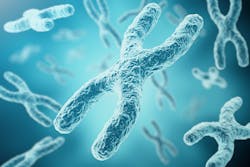Researchers at the National Human Genome Research Institute (NHGRI), part of the National Institutes of Health (NIH), have produced the first end-to-end DNA sequence of a human chromosome. The results, published in Nature, show that generating a precise, base-by-base sequence of a human chromosome is now possible, and will enable researchers to produce a complete sequence of the human genome, according to a release from NHGRI.
In this study, researchers did not sequence the X chromosome from a normal human cell. Instead, they used a special cell type – one that has two identical X chromosomes. Such a cell provides more DNA for sequencing than a male cell, which has only a single copy of an X chromosome. It also avoids sequence differences encountered when analyzing two X chromosomes of a typical female cell.
The authors and their colleagues capitalized on new technologies that can sequence long segments of DNA. Instead of preparing and analyzing small pieces of DNA, they used a method that leaves DNA molecules largely intact. These large DNA molecules were then analyzed by two different instruments, each of which generates very long DNA sequences – something previous instruments could not accomplish.
After analyzing the human X chromosome in this fashion, researchers used their newly developed computer program to assemble the many segments of generated sequence. One group led the effort to close the largest remaining sequence gap on the X chromosome, the roughly 3 million bases of repetitive DNA found at the middle portion of the chromosome, called the centromere.
The effort is part of a broader initiative by the Telomere-to-Telomere (T2T) consortium, partially funded by NHGRI. The consortium aims to generate a more complete reference sequence of the human genome. The T2T consortium is continuing its efforts with the remaining human chromosomes, aiming to generate a complete human genome sequence in 2020.

